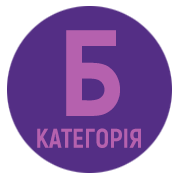DEVELOPMENTAL COORDINATION DISORDER (DCD) AND NON-VERBAL PRESCHOOL CHILDREN: DIAGNOSTIC, CORRECTION IN THE CONDITION OF THE STATE OF WAR
DOI:
https://doi.org/10.32782/inclusion/2023.2.7Keywords:
speechless children, speech disorders, higher mental functions, Developmental Coordination Disorder (DCD), preschool age, diagnosis.Abstract
The article considers different approaches to defining the term “Developmental Coordination Disorder” (DCD). The main causes and main manifestations of DCD are considered: clinical manifestations of minimal brain dysfunction, pre- and postnatal pathology, psychosocial causes. The diagnosis and the scheme of complex corrective and restorative work for children with DCD are given. Today MMD is a fairly common phenomenon of various origins, which in most cases causes various manifestations of disorders of psychophysical development. Among them are speech disorders. Speech disorders caused by MMD can act as an independent group of disorders, as well as accompanying symptoms in: mental retardation (PR), intellectual disorders of varying degrees of severity, etc. Modern research in the field of special education, in particular speech therapy, shows that in most cases it is MMD that causes the phenomenon of lack of speech. When at certain stages of ontogenesis, a child has a total delay in speech development, which acquires signs of the absence of speech. In terms of pedagogy, children who at a certain age do not master speech as a means of communication are called “children without speech”. The theoretical and experimental lack of development of the problem of early diagnostic and corrective care for speechless children in a sensitive period of development makes it difficult to activate its adaptive and compensatory capabilities. Understanding the positions of leading scientists in the field of special, age-related psychology, analysis of experimental data on the problem of researching the psycho-speech development of a selected category of children in the unity of early and preschool age showed that the issue of comprehensive intervention to help these children has not been fully resolved. Defining the terminologically meaningful aspect of the concept of psycho-speech development in relation to the relevant age periods, we consider it integrative in relation to mental, speech, intellectual, emotional-volitional development, which has a certain structure, the variability of which is characterized by individual-typical features of impaired development in the absence of speech, which are the basis of the author’s understanding of the essence of this phenomenon. Provision of timely comprehensive assistance to speechless children with DCD is a guarantee of their further socialization and improvement of the quality of life in general, however, with the beginning of hostilities on the territory of Ukraine, the provision of this assistance has certain peculiarities.
References
Бернхал Дж., Банксон Н. Артикуляційні та фонетичні розлади. Клінічна лінгвістика та фонетика. Бостон. 2014. № 19. С. 53–66.
Вейнер Дж., Дулкан М. Американська психіатрична асоціація. Діагностичний та статистичний посібник з психічних розладів (DSM-IV). Вашингтон, Лондон, Англія. 2014. 36 с.
Девіс Б. Диференціальна діагностика та лікування апраксії розвитку мовлення у немовлят і дітей раннього віку. Втручання раннього віку : трансдисциплінарний журнал. 2020. № 10. С. 177–192.
Ді Лаццаро В. Фізіологічні основи транскраніальної моторної стимуляції кори головного мозку у свідомих людей. Клінічна нейрофізіологія. 2014. № 115 (2). С 255–266.
Екелмен Б., Арам Д. Синтаксичні знахідки при вербальній атаксії розвитку. Журнал мовленнєвих порушень. 2019. № 16. С. 237–250.
Клом’яй В., Катс Р., Лакмі-Вале А. Основні принципи транскраніальної магнітної стимуляції (TMS) і повторюваної TMS (rTMS). Ann Phys Rehabil Med. 2015 рік. № 58(4). С. 208–213. DOI: 10.1016/j.rehab.2015.05.005.
Льюїс Б.А. Подальше спостереження за дітьми з дитячою апраксією мовлення в шкільному віці. Мовлення, мова та слухомовленнєвий розвиток у школах. 2014. № 35. С 122–140.
Маасен Б. Коартикуляція між складами у дітей з апраксією розвитку мовлення. Клінічна лінгвістика та фонетика. 2021. № 15. С. 145–150.
Макалуко-Хайнес С. Апраксія розвитку мовлення: симптоми та терапія. Клінічне лікування нейрогенних комунікаційних розладів. 2018. № 66. С. 243–250.
Маккарб П., Розенталь Дж., Мклеод С. Особливості розвитку диспраксії в загальній популяції з вадами мовлення. Клінічна лінгвістика та фонетика. 2016. № 12. С. 105–126.
Міщук Т.М., Каландяк О.М. Великі проблеми мінімальної мозкової дисфункції, або Що ми знаємо про моторну незграбність? НейроNEWS. 2022. № 6-2. С. 33–35.
Міссуіна К., Джейнес Р., Сусіє Г. Батьківські питання про розлад координації розвитку: короткий опис поточних даних. Педіатрія та здоров’я дитини. 2016. №. 11. С. 507–512.
Міссуіна К., Поллок Н., Іган М. Сприяти професії через полегшення діагностики розладу координації розвитку. Канадський журнал професійної терапії. 2018. 1. С. 26–34.
Моррісон Дж. DSM-IV. Зробити це легко. Керівництво клініциста з діагностики. Нью-Йорк : The Guilford Press, 2015.
Михайлова Е.О., Сухоносова О.Ю. та ін. Оптимізація лікування психічних, неврологічних та психосоматичних розладів у дітей. Інформаційний лист МОЗ України. Київ, 2020.133 с.
Найленд Л., Маассен Б., Ван дер Мейлен та інші. Коартикуляційні патерни в дітей з порушенням мовлення. Клінічна лінгвістика та фонетика. 2022. № 16. С. 461–483.
Полатайко Г.Дж., Фокс М., Місіуна К. (2015). Міжнародний консенсус щодо дітей з порушенням координації розвитку. Канадський журнал професійної терапії. 2015. № 62. С. 3–6.
Форрест К. Діагностичні критерії апраксії розвитку мовлення, які використовуються клінічними логопедами. Американський журнал логопедії. 2019. № 12. С. 376–380.
Флетчер С.Г. Чи корисні орально-моторні вправи при лікуванні фонологічних/артикуляційних розладів? Семінари з мовлення. 2022. № 23. С. 15–26.
Хол П.К. Апраксія мовлення: теорія і клінічна практика. Acta Pædiatrica. 2016. № 85. С. 1197–1201.
Шейла Е., Хендерсон С., Сагден Д., Барнетт А. Батарея оцінки рухів для дітей. Друге видання. Посібник екзаменатора. Pearsen, Лондон, 2017. 23 с.







